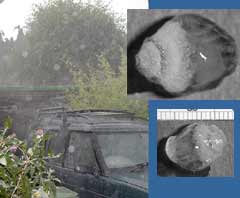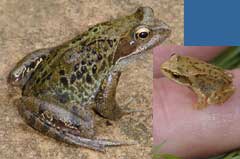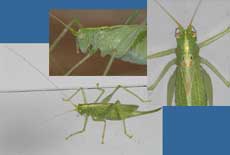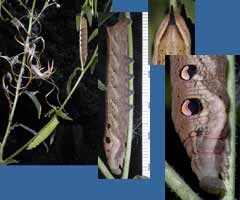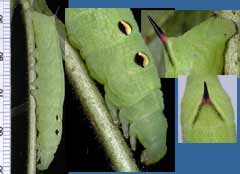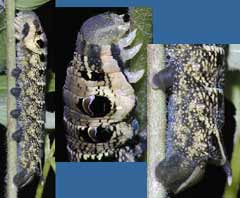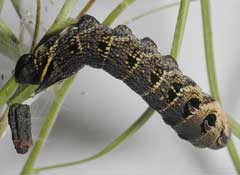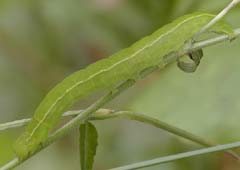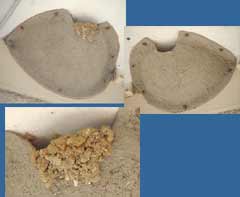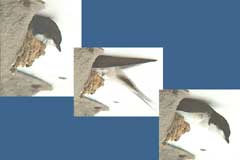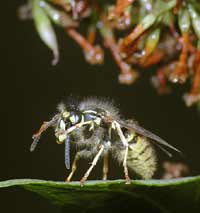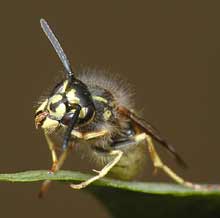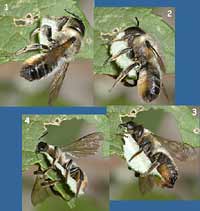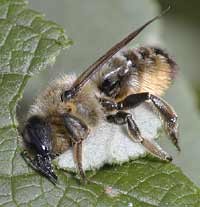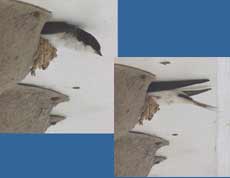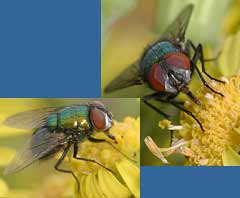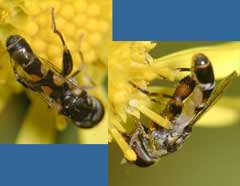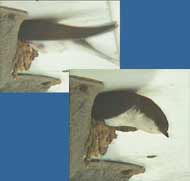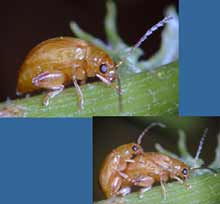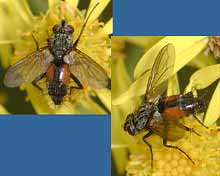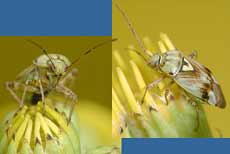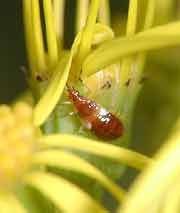Go to last entry on this page......................Go to previous entry9 August - We are home - in fact, we came home last Wednesday evening (4th) after a very enjoyable few weeks, with most days spent in a small cove called Porthallow. As usual, I took a variety of wildlife photographs down there, but I haven't started to transfer them to the PC yet. I will be doing so in the next few days and I will then add a second half to my July diary to cover the trip. Very warm, humid weather during our absence made sure that the garden was even more of a jungle than usual this time and so a lot of time has been taken up trying to put it straight again. My old 2-stroke mower finally gave up and I had to get a new one (we don't have much grass to cut but the layout of the garden means that the cable on an electric mower is too much of a liability). The day after we returned (the 5th) we had the most violent rain storm I can ever recall happening here. The local weather station (top of my links page) registered some 29mm of rain, which must have fallen in only about 20 minutes. In addition, there was thunder and lightning, hail and very strong winds from the East which seemed to swirl all around the place. At one stage the Birch tree was bent right over and a few smaller branches were snapped off.
We live on a slope, and the road outside became a river but the wind and rain prevented my from getting any decent photographs of that. Today we visited our local library. The whole place had the odour of damp carpets, and there were large industrial dehumidifiers operating as they continue to recover from the effects of that storm. Since then the weather has remained very warm and humid. The weather forecasters were promising more 'tropical rain' today. That seems to have missed us, but it has been dull all day and this afternoon we have had drizzle and 'less violent' rain.
After the storm the garden was alive with frogs of all sizes from tiny, newly emerged individuals (smaller than the one on my finger) right up to mature frogs that spend all their time in and around the pond. This evening I again spent time watching them as we had a meal on the veranda.
I think it is a female Oak Bush-cricket, and although I have often found this species in the garden I rarely come across an adult.
As the left-hand image shows, although both caterpillars were on the same plant, one was pale brown while the other was bright green. A look at my guide books confirmed that both are larvae of the Elephant Hawk Moth. I have never seen an adult here, but I did take some photographs of one in Cornwall. I shall add those pictures later.
Also, the front end of the body, beyond the eye-spots was thought to resemble an elephant's trunk when the head is extended - hence the common name.
I decided to plant a few Willowherbs into a pot so I could watch the caterpillars for a few days. and I'm very glad I did. Up to first thing yesterday the caterpillars seemed to have done very little but when I looked at the later in the day the green one had undergone a dramatic change. The guide book stated that the caterpillars can be green when young, and this one must have undergone a moult during the course of the day.
This morning I found that the brown coloured caterpillar had also undergone a moult to take on a similar, dramatic look. This time I was able to photograph what I assume is the moulted skin still hanging by a single thread from the caterpillar. Today, both caterpillars have been quietly munching away on both the leaves and seed pods of the Willowherb.
I spotted this one as it was being attacked by what appeared to be a social wasp. The wasp seemed to swoop down on it several times but didn't land. Some time later I found the caterpillar dead in the water.
10 August - A wet night and morning has given way to a bright and sunny afternoon and it isn't as hot today. A long time ago there used to be House Martins nesting along our road, although not on our house. However, over the last few years I have seen fewer and fewer of them, and this Spring I could only see Swifts definitely nesting, and they were further down the road. Long before I built the big Blue Tit nest box in the back garden I made some artificial Martin nestboxes and put them up under a a section of roof that overhangs at the front of the house in the hope that we could attract Martins. Over the years the boxes have been used as roosts by sparrows who managed to enlarge the entrances, but we had never seen Martins approach them - until this morning!
I hadn't even given the boxes a glance since our return from holiday, but a neighbour of ours (John) came past as I took these pictures and confirmed that he had seen activity there while we were in Cornwall.
In these images (grabbed from video taken at an angle through rather dirty double glazing!) the left hand picture shows one partner looking out. The second bird landed briefly at the entrance to another of the boxes before entering this one (centre). The first bird left as soon as its tail disappeared inside. I would guess that this behaviour suggests that there are eggs being incubated, although I need to watch a lot more and get advice from elsewhere before being certain. The video images are not brilliant and I hope to improve the quality for future diary entries. During the afternoon at least one of the pair was in the nest for most of the time, except for two periods of about 30 minutes each when both birds were, I assume, with the others that we could see high above the neighbourhood. There was a period of about 3 minutes when both birds were in the nest. At about 7.50pm The male was seen feeding his partner at the nest entrance, although I wasn't able to grab a decent image of the all too brief moment. A short while later he returned to the nest and stayed for a couple of minutes before one of them left again, returning just before 8.30pm. There was another departure a minute later but that bird hadn't returned when the video stopped recording at 8.50pm. Sunset today was at 8.32pm.
When this morning's rain stopped I spent a good few minutes watching this wasp cleaning itself on a Buddlea leaf. As it cleaned, all parts of its body received attention numerous times. Here it uses its front legs to clean its antennae, a job that must have been done at least ten times.
Afterwards, it turned its attention to those legs and in this image you can see that it has its foot in its mouth, having worked along much of the leg. The wasps seem to be particularly active this summer - Sheila was stung by one yesterday (with no ill effects) as she brushed off something that she felt land on the back of her leg!
11 August - A largely dry, bright day with just a few showers first thing this morning. The House Martins are continuing to (I assume) incubate eggs with one or other of the birds in the nest most of the time. I have looked through video recordings of the nest for the period between 8.50am and 2pm. I didn't see any activity until 10.09am when the occupant left the box. A bird returned(?) just 1 minute later. After that, the nest was left unoccupied only once more, for about 16 minutes at 1.22pm. During the rest of the time the pair swapped places some ten times, each 'shift' lasting anywhere from 5 to 31 minutes (averaging just over 13 minutes). This evening I looked through another 4 hours of video, covering up to 6pm. This afternoon was very different to the morning. At 2.04pm the bird left the nest for about 5 minutes. When an adult returned it stayed for 86 minutes before its partner relieved it. That bird then remained for 62 minutes before it left. The nest remained unoccupied for 36 minutes before an adult returned once again. Having seen only the female incubating in the nesting of the Blackbird, Robin, Blue and Great Tits it's quite a change to see both parents involved. In the garden, one of the Elephant Hawk Moth caterpillars had disappeared from the plants in the pot this morning, and this afternoon the other one decided to follow suite, so I have put it onto another Willowherb plant that is growing just beyond the ponds. It's still there a couple of hours later - I'll be checking again in the morning.
This afternoon Sheila and I watched as this one travelled back and forth between the bamboo 'nest tube' and a Buddlea plant as it sealed up the hole. The sequence shows it folding the leaf disc between its legs as it snips along a circular path. When the last cut is made it simply falls a short way from the leaf before its wings propel it forwards.
Here is a closer view of the same bee in action on another Buddlea leaf.
Another of my regulars needs a mention. The Orange Ladybirds are very active at the moment, with all four life stages evident on the Birch, including mating pairs. On the weekend I counted 15 adults, which I think is the highest number I've seen at one time.
13 August - Having commented about the Orange ladybird numbers last weekend, today I couldn't find any adults!
I'm having a problem getting decent images through the double glazing of the bedroom window, and with up to an hour or more between change-overs I'm afraid I'm not getting much chance to improve!
Late this afternoon Sheila spotted a head poking out of the nestbox at the other end of the group - A house sparrow was in residence. During the morning I watched a couple of Sparrowhawks who appeared to be playing high above the rooftops, with one swooping down at the other several times as they circled round. Shortly afterwards one swooped on our Hawthorn but did not make a serious attempt to dislodge any of the Sparrows hidden in its branches.
These images show a Greenbottle (Lucilia caesar) feeding. There were a number of these flies about and their metallic blue-green colour really contrast with their red eyes in the sunshine.
There were numerous hoverflies about, and this one caught my eye as being a bit different. I think it is a Thick-legged Hoverfly (Syritta pipiens), its name referring to the thick top section (femur) of its hind legs. A gust of wind took it away before I could get any good images that included its head.
18 August - I'm not finding it easy to keep up with my diary at the moment. While I blame much of the trouble on my CFS, it doesn't help when the weather is not as good as it could be, with lots of cloud and heavy showers, and the camera problem does mean that photo-opportunities are being lost. It has been great weather for the frogs! Anyway, I've had a bit of encouragement today, with the arrival of an e-mail from a publishing company that may be interested in using some of my photographs in educational books for young children - my fingers are crossed - it may help towards getting the camera sorted out!
It is eight days since we first noticed their nesting and my guide book gives 13-19 days for incubation. With another 19-25 days to follow before fledging (taking them well into September), I hope we see a change in behaviour soon that indicates that the chicks have hatched. I also hope that the rather miserably changeable weather will not prevent them from succeeding. In an air of confidence I have been planning changes to allow a camera to look into the nest from our loft next year. precise plans will have to wait until the Martins have left and I can check the positions of rafters. Back on the 13th I commented on the disappearance of the Orange Ladybird adults from the Birch tree. There are still none to be seen, but, as I planted a new Buddlea bush near the Ivy tree I found one that was under leaf debris. At first I thought it was dead, so I put it into a seed tray to examine later. When I checked on it some five minutes later it had come back to live and soon climbed out of the tray. I notice that last I couldn't find adults in the second half of August but, as is the case at the moment, there were larvae and pupae present. When I checked the tree today I also found two groups of eggs, presumably laid following the mating that I saw back on the 11th.
The Holly Blues have been interesting in that I rarely see them at the house end of the garden, but they frequently visit the Ivy tree, as shown here. I'm not sure whether they are simply using it as a place to 'sunbathe', or because they can detect the first odours from the developing Ivy flowers which are now developing in clumps at the end of many of the stems.
I was interested to find out form the internet that these beetles were introduced into Tasmania in 1979 in an effort to control Ragwort. Up to four weeks after mating (lower image) the eggs will be laid in the soil below the plant, and it is the larvae that attack the roots. I'm also taking measures to prevent the Ragwort from spreading. Each day I check the flower heads and remove any that have gone to seed. I also dig up any new plants that appear in the garden with the aim of just allowing a couple of plants to flower.
Here is one of the more unusual visitors to the Ragwort, seen just once this summer. Last photographed on 22August 2002, it was also on the Ragwort on that occasion. I think it is Eriothrix rufomaculatus, the larva of which is parasitic on caterpillars. It is a common fly despite not appearing in either of my insect guides.
There are several of these small bugs on the Ragwort at the moment. They look like Tarnished Plant Bugs (Lygus pratensis), but I cannot be certain about that.
In addition to adult bugs, I also spotted, and managed to get just one photograph of, this brightly coloured nymph - I have no idea as to what species it is.
|
|
